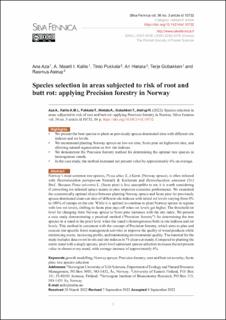| dc.contributor.author | Ferreira Aza, Ana Claudia | |
| dc.contributor.author | Kallio, Maarit | |
| dc.contributor.author | Pukkala, Timo | |
| dc.contributor.author | Hietala, Ari Mikko | |
| dc.contributor.author | Gobakken, Terje | |
| dc.contributor.author | Astrup, Rasmus Andreas | |
| dc.date.accessioned | 2022-10-13T11:31:57Z | |
| dc.date.available | 2022-10-13T11:31:57Z | |
| dc.date.created | 2022-09-23T10:29:56Z | |
| dc.date.issued | 2022-09-13 | |
| dc.identifier.citation | Silva Fennica. 2022, 56 (3), 1-16. | en_US |
| dc.identifier.issn | 0037-5330 | |
| dc.identifier.uri | https://hdl.handle.net/11250/3025889 | |
| dc.description.abstract | Norway’s most common tree species, Picea abies (L.) Karst. (Norway spruce), is often infected with Heterobasidion parviporum Niemelä & Korhonen and Heterobasidion annosum (Fr.) Bref.. Because Pinus sylvestris L. (Scots pine) is less susceptible to rot, it is worth considering if converting rot-infested spruce stands to pine improves economic performance. We examined the economically optimal choice between planting Norway spruce and Scots pine for previously spruce-dominated clear-cut sites of different site indexes with initial rot levels varying from 0% to 100% of stumps on the site. While it is optimal to continue to plant Norway spruce in regions with low rot levels, shifting to Scots pine pays off when rot levels get higher. The threshold rot level for changing from Norway spruce to Scots pine increases with the site index. We present a case study demonstrating a practical method (“Precision forestry”) for determining the tree species in a stand at the pixel level when the stand is heterogeneous both in site indexes and rot levels. This method is consistent with the concept of Precision forestry, which aims to plan and execute site-specific forest management activities to improve the quality of wood products while minimising waste, increasing profits, and maintaining environmental quality. The material for the study includes data on rot levels and site indexes in 71 clear-cut stands. Compared to planting the entire stand with a single species, pixel-level optimised species selection increases the net present value in almost every stand, with average increase of approximately 6%. | en_US |
| dc.description.abstract | Species selection in areas subjected to risk of root and butt rot: applying Precision forestry in Norway | en_US |
| dc.language.iso | eng | en_US |
| dc.publisher | Finnish Society of Forest Science | en_US |
| dc.rights | Navngivelse-DelPåSammeVilkår 4.0 Internasjonal | * |
| dc.rights.uri | http://creativecommons.org/licenses/by-sa/4.0/deed.no | * |
| dc.title | Species selection in areas subjected to risk of root and butt rot: applying Precision forestry in Norway | en_US |
| dc.title.alternative | Species selection in areas subjected to risk of root and butt rot: applying Precision forestry in Norway | en_US |
| dc.type | Peer reviewed | en_US |
| dc.type | Journal article | en_US |
| dc.description.version | publishedVersion | en_US |
| dc.rights.holder | © 2022 The Authors | en_US |
| dc.source.pagenumber | 1-16 | en_US |
| dc.source.volume | 56 | en_US |
| dc.source.journal | Silva Fennica | en_US |
| dc.source.issue | 3 | en_US |
| dc.identifier.doi | 10.14214/sf.10732 | |
| dc.identifier.cristin | 2054688 | |
| dc.relation.project | Norges forskningsråd: 281140 | en_US |
| dc.source.articlenumber | 10732 | en_US |
| cristin.ispublished | true | |
| cristin.fulltext | original | |
| cristin.qualitycode | 1 | |

